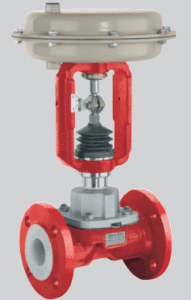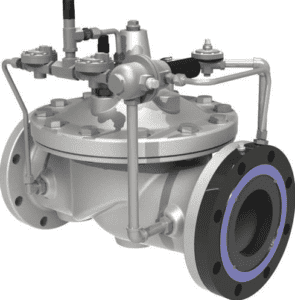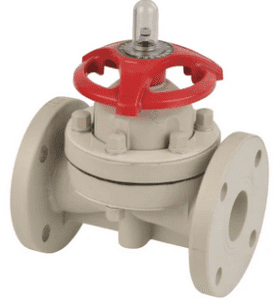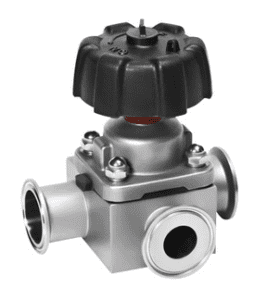Wire Type Diaphragm Valve
Wire Type Diaphragm Valve
NTGD is professional wire type diaphragm valve manufacturer, we aim to offer quality valve with competive price and fast delivery time. Feel free to contact us
What is the weir type diaphragm valve?
This is a diaphragm valve that is designed with a raised weir on the fluid flow passage. The weir on the flow path helps to control diaphragm flexing to a minimum while maintaining streamlined and smooth fluid flow. As such, the diaphragm flexing stress is minimized resulting in longer diaphragm life. This valve operates by moving the diaphragm up to allow fluid flow and when the diaphragm moves downwards it closes. Weir-type diaphragm valve manufacturers design this valve for use in various applications from general use to specific industrial use. The use of the valve depends on the material used to make different parts such as the diaphragm, seals, and even the valve body. The body is mostly made of metallic materials such as carbon steel, stainless steel, and ductile iron. Such materials are very strong and they make the valve very strong against high pressure and impact damage.

Parts of a weir-type diaphragm valve
Handwheel
The handwheel is a component placed on top of the valve and it is used by the operator to regulate fluid flow. The handwheel has its lower end connected to another component known as a stem that transmits torque to the other parts.
Stem
This is a threaded component that has its top end connected to the handwheel. This part of a weir-type diaphragm valve is used to transmit the torque applied on the handwheel to the diaphragm. The stem can be rising or non-rising. The rising stem helps to indicate when the valve is closed or when it is open and they extend above the handwheel. This type of stem is used where space is not limited. The non-raising stem does not extend past the handwheel and it is used where space is limited.
Compressor
This is the component that is placed between the stem and diaphragm. This component is meant to support the diaphragm. Weir-type diaphragm valve manufacturers optimize the compressor design to enhance better fluid throttling.
Diaphragm
This is an internal component of a weir-type diaphragm valve that is connected to the compressor. The work of the diaphragm is to provide a tight seal that prevents fluid flow through the valve. The tight seal is created by pressing the diaphragm tightly to the bottom part of the valve body.
The diaphragm works by getting power from the handwheel through the stem and compressor.
Valve body
This is an external component of a weir-type diaphragm valve which is used to house the diaphragm and seals. The body is usually made of metallic materials like carbon steel, stainless steel, and ductile iron among other strong materials. The high strength is meant to protect internal parts against damage as well as make the valve withstand high pressure.
Bonnet
The bonnet in a weir-type diaphragm valve is placed on top of the valve body. The body and bonnet are made of the same material to enhance uniform and tight connection. Bonnet is meant to house non-wetted parts of the valve like the compressor, stem, and handwheel mechanism.
Gaskets
The gasket is a component placed between the valve and the pipe. It serves to prevent any fluid leakage through the valve and pipe connection.
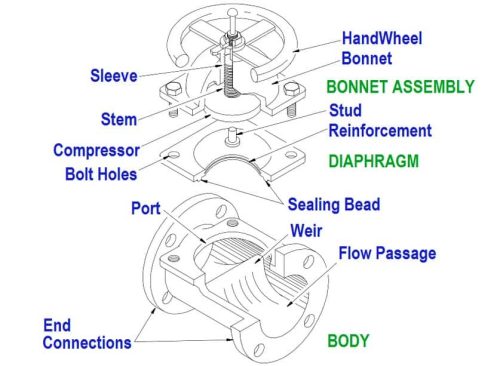
How does a weir-type diaphragm valve work?
A weir-type diaphragm valve operates by employing vertical linear motion. This motion is initiated by the application of torque on the handwheel. This torque makes both the handwheel and stem start rotating. The rotary motion is converted to linear motion by threads on the stem. Since the stem is connected to the compressor, as it starts moving it forces the compressor to move either up or down. To open the fluid flow through the valve, the handwheel is turned to the clockwise direction. This forces the diaphragm connected to the compressor upwards which opens a passage for the fluid flow. The fluid then keeps flowing until the handwheel is turned counterclockwise forcing the diaphragm to move downwards and creating a tight seal against the fluid flow. This then prevents any attempts of the fluid to flow through the valve. Weir-type diaphragm valve manufacturers also recommend these valves for use in throttling flow applications. For throttling flow, the handwheel is turned slightly allowing some amount of fluid to flow through the valve.
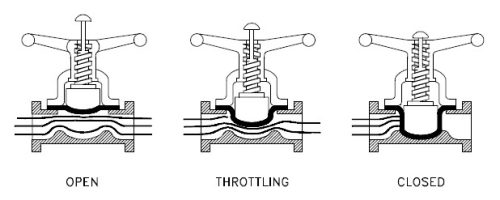
Types of weir-type diaphragm valves
Manual weir type diaphragm valve
This is the type weir type diaphragm valve that is operated manually. This valve comes with a handwheel where the operator applies force to manually turn the handwheel. This type of valve is very common and cheaper compared to the automatic types. However, this type of valve tends to be tedious because of the operating torque and more so where frequent valve operations are needed.
Figure: Manual weir type diaphragm valve.
Automatic weir type diaphragm valve
This is the type of valve that is operated using an actuator. The actuator is meant to provide the torque that is used to open or close the valve. Weir-type diaphragm valve manufacturers design these valves such that they can determine when to open and close the valve as well as regulate the amount of fluid flow. There are three types of actuators used in this type of valve that is electric actuator, pneumatic actuator, and hydraulic actuator.
Electric actuator: This actuator operates by using electrical energy. Weir-type diaphragm valve manufacturers design this actuator with an electrical and mechanical system that transforms electrical to mechanical energy. The mechanical energy is in terms of torque used to control the valve.
Figure: Weir type diaphragm valve with electric actuator.
Pneumatic actuator: This actuator works by using air or gas. Air is compressed to high pressure and used to turn a piston that provides the torque needed to operate the valve. This type of actuator is versatile as it can be used in various applications ranging from foods to corrosives. For hygienic and food applications, the air or gas to be used in the actuator can be filtered to remove dirt and other impurities making it safe for handling consumable products.
Figure: Weir type diaphragm valve with pneumatic actuator.
Hydraulic actuator: This is the actuator that operates by using hydraulic fluid. This type of actuator is suitable for use where the weir type diaphragm valve needs a lot of torque to operate. This is because hydraulic systems produce a lot of energy due to the incompressible property of hydraulic fluids. However, this type of actuator is mostly affected by high temperatures and is not recommended for handling food products due to contamination.
Figure: Weir type diaphragm valve with hydraulic actuator.
Plastic weir type diaphragm valve
This is a special weir-type diaphragm valve that is made of plastic material. Weir-type diaphragm valve manufacturers produce this valve for use in corrosives and low temperatures. This valve is preferred for its low cost relative to the metallic ones. Because of the use of plastic material, this type of valve is light in weight compared to metallic types. Plastic weir-type diaphragm valves can be used in a wide range of applications such as water supply, food, and beverages, and chemical handling among others. However, the use of this valve should only be restricted to low temperatures since plastics have low melting points.
Figure: Plastic weir type diaphragm valve.
Three-way weir type diaphragm valve
This is a weir-type diaphragm valve designed with three ports. With this type of valve, you can divert fluid to flow in two different directions from one source. This helps to reduce the cost of using two valves. Weir-type diaphragm valve manufacturers design the valve with a threaded bonnet to allow for the weir to be aligned directly to the inner diameter of the pipe. Such a design helps to eliminate dead legs and contamination.
Figure: Three-way weir type diaphragm valve.
Applications of weir-type diaphragm valves
- These valves are used in heating, ventilation and air conditioning (HVAC) systems.
- These valves are used in water supply and treatment.
- Weir-type diaphragm valves are used in chemical processing plants.
- They are used to control the flow of products in food processing plants.
- These valves are used in fire hydrants to control the flow of water used in firefighting.
- Weir-type diaphragm valves are used in an oil refinery.
- These valves are used in paper and pulp manufacturing.
- Weir type diaphragm valves are used in firefighting applications.
- They are used in pharmaceutical manufacturing plants.
Advantages of weir-type diaphragm valves
- These valves are bi-directional allowing fluid flow in either direction.
- Weir-type diaphragm valves have a reliable seal that ensures no fluid leakage.
- These valves are resistant to corrosion.
- They can be manual or automatic depending on the user’s preferences.
- Weir-type diaphragm valves are easy to clean, repair and do maintenance.
- These valves are simple and compact in design.
- Weir-type diaphragm valves can be used in different industrial applications due to their versatile nature.
- These valves can handle viscous fluids and slurries.
- They can be used in throttling fluid flow.
- Weir-type diaphragm valves do not have pockets that can trap impurities.
Disadvantages of weir-type diaphragm valves
- These valves have a weir component that tends to interfere with complete draining of the pipe.
- Weir-type diaphragm valves tend to reduce hydrostatic pressure which reduces working efficiency.
Troubleshooting weir-type diaphragm valves
The handwheel rotates but the valve does not operate
- Damaged stem. Replace the stem.
The valve is hard to operate
- Foreign materials between the body and stem. Open the valve according to the instructions given by the weir-type diaphragm valve manufacturer and remove foreign materials.
- Damaged stem. Replace the stem.
Ruptured diaphragm
- Excess fluid pressure. Operate the valve at the recommended pressure.
- Materials clogged between the diaphragm and the body or seat. Open the valve and remove the clogged materials.
- Excess opening height. Do not exceed the recommended opening height.
- The diaphragm has been exhausted. Replace the diaphragm.
Leakage between the body and the bonnet
- Loose connection. Tighten the elements connecting the bonnet and the valve body to attain the torque mentioned by the weir-type diaphragm valve manufacturer.
- Worn out or damaged bonnet seals. Replace the seals.
Leakage between the body and the pipe connection
- Loose connection. Tighten the connecting elements to attain the required torque.
- Damaged or worn-out gasket. Replace the gasket.
Fluid leakage through the stem
- The diaphragm is damaged. Replace the diaphragm.
Summary
The weir-type diaphragm valve is a type of valve designed with a raised lip. The raised lip is known as the weir and it serves to provide the resting position of the diaphragm to seal against fluid flow. This type of valve is known for its reliable seal when it is closed relative to other diaphragm valves. Weir-type diaphragm valve manufacturers design this valve to operate by use of a handwheel or by using actuators. Whether the valve is driven manually or automatically, the working principle is the same. The working principle is that the handwheel or actuator rotates the valve stem. The stem then operates the diaphragm through the valve compressor. This forces the diaphragm to move either upwards to open the valve or move downwards to close the valve as necessary.
Weir type diaphragm valve manufacturers produce various types of this valve such as plastic weir type diaphragm valves, manual weir type diaphragm valves, automatic weir type diaphragm valves, and three-way weir type diaphragm valves among others. The areas where this valve can be used include paper and pulp, oil refinery, corrosives, food processing, water supply and treatment, and firefighting among others. The advantages of purchasing a weir-type diaphragm valve are bi-directional fluid flow, versatility, easy cleaning, repair, and maintenance, compact and simple design, zero leakage, and suitable for throttling fluid flow.



